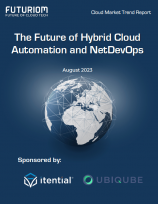What Is Hybrid Cloud Network Automation?

This Tech Primer is Sponsored by Itential. Futuriom recently authored a hybrid cloud network automation whitepaper with Itential, which can be read here.
Many technology forces are driving information technology (IT) systems and resources to the cloud: Digital transformation projects, hybrid work arrangements, automation, and data analytics – just to name a few.
As the cloud move accelerates, there is also growing interest in combining or using a variety of cloud platforms and services, including private datacenter resources -- a movement known as hybrid cloud. Organizations are considering using hybrid and multicloud approaches to enable many forms of cloud services to provide better flexibility, scale, and lower cloud costs. it can also help them hedge their investments by avoiding lock-in to specific cloud service providers.
But what does this mean for networking infrastructure? Few organizations have a networking infrastructure that is up for the task of connecting complex hybrid and multicloud environments. As organizations move to hybrid and multicloud architectures, one of the largest barriers is the networking infrastructure.
This has given birth to a new approach to hybrid cloud network automation. This cloud networking approach uses software building blocks to connect to many different types of cloud networks, enterprise networks, and other networking domains. Hybrid cloud network automation will be used to orchestrate, secure, and manage complex multicloud or hybrid cloud connections.
Why Is Hybrid Cloud Network Automation Needed Now?
The cloud-enabled transformation is occurring rapidly but also has a long runway. By most metrics, the cloud has only achieved 10% to 20% of market penetration on an application workload basis. It will require new hybrid and multicloud architectures to take advantage of the best cloud resources, wherever they reside.
One of the biggest barriers to this multicloud transformation is the typical enterprise network, which must be modernized to be able to connect multiple clouds and resources. In Futuriom’s 2021 MCN survey, 120 enterprise networking and IT experts were asked how they view the use of public cloud infrastructure. Of those surveyed, 55.6% use two or more public cloud providers; 28.7% said they use a single public cloud provider. Of the 120 respondents surveyed, only 11.9% said they don’t use a public cloud provider but have plans to, and 4% said they have no plans to use public cloud providers.
Adopting hybrid and multicloud services is not a simple proposition. Cloud infrastructure consists of many different types of platforms and services: software-as-a-service (SaaS) applications, platform-as-a-service (PaaS), and infrastructure-as-a-service (IaaS). These services come in many shapes and sizes, with niche offerings such as business analytics, AI/ML, security services, and Internet of Things (IoT), just to name a few. At the same time, organizations may have traditional enterprise or datacenter resources they would like to utilize or integrate with cloud services.
IT and networking professionals will need to ensure they have a defensible and safe infrastructure to support hybrid and multicloud environments. Considerations include data sovereignty, security, and governance. Increasingly, management is concerned about how and where data and applications can be secured, monitored, and checked for compliance.
Networks, which are responsible for connecting clouds with applications and carry all the data, will be crucial to these efforts. In many cases, networking will prove to be a major challenge. Most networks have been built with specific environments, or “domains,” in mind – for example, an enterprise branch, a datacenter (private or public), or industrial setting. Connecting these different computing domains or platforms requires a flexible networking infrastructure that can also be managed and monitored to ensure security and compliance.
Existing references to network automation are often focused on one silo – enterprise, datacenter, or cloud – and aren’t useful in automating all networks. A new kind of network automation is needed to coordinate the entire realm of networks: service mesh, overlay networks, and traditional underlays.
The next step for the cloud migration is to build more flexible networking platforms that can span the bridge between all of these silos: enterprise, datacenter, and public cloud. This networking approach needs to use software and automation to dynamically provision, manage, and integrate management of the networks that can link traditional enterprise networks, private data centers, and public cloud platforms and services.
The Building Blocks of Hybrid Cloud Network Automation
Using application programming interfaces (APIs), networking standards, and software automation, a hybrid network automation approach can tie together any networking domain, whether it’s traditional networking infrastructure or software-defined wide-area networking (SD-WAN) branches. This is where networking automation is going.
The building blocks of network automation are industry data models and standards such as NETCONF YANG, OpenConfig, or APIs provided by original equipment manufacturers (OEMs) and software providers. These software tools enable network automation and orchestration by providing standardized software models that enable networking hardware to be programmed with code – a movement known as infrastructure as code.
These tools can be used to program and automate networks today. By using software to program how networks are configured, monitored, tested, and operated, the path to hybrid network automation is clear. The challenge for organizations is that so far, it has been done in a fragmented and customized way – with a wide variety of tools, often requiring complex custom integrations.
What’s needed is a platform that takes the burden off the organization for managing network integration code, manual configuration management, and even network compliance.
This includes:
- Pre-built network integration that can be standardized on the management platform so that customers don’t need to maintain custom network integrations themselves.
- Federation of networking configuration data and standards, using data or modeling languages such as YANG, YAML, JSON, and TOSCA and putting this data into an easily understood JSON Schema.
- Compliance management, such as defined golden configuration standards for both traditional and cloud networks, helping to ensure compliance and providing automated remediation.
- Integration with any command-line interface (CLI) or network operating system (NOS), including third-party NOSs, cloud controllers, orchestrators, DevOps and NetOps tools, inventory, IT service management (ITSM), IP address management (IPAM), messaging systems, SD-WAN, security, telemetry, analytics. Sound impossible? It’s not.
- Integration with third-party monitoring and pipeline systems, providing event-driven capabilities for NetOps teams to use a closed-loop approach to automate the detection of anomalies, determine a resolution, and implement the required changes.
- A single aggregated network management view, with an API that enables networking teams to manage hybrid networks as a single, logical entity. This enables self-service for anybody in IT.
- Pre-built automations for top use cases that are plug and play for NetOps teams, with low-code drag-and-drop capabilities.
As you can see, there is a wide array of needs in delivering true hybrid cloud network automation. Not only do networking managers need a better way to connect and manage cloud networks, but builders of cloud applications and members of DevOps teams want to build networking and security into their software deployments.
The big question is: Will organizations want to do this themselves, or will they move to specially developed hybrid cloud network automation platforms? Futuriom believes the future lies in network automation platforms that can abstract the complexity out of the network for the end users.
Already, a wide variety of tools are emerging to deliver hybrid cloud network automation. This has been covered in our recent multicloud networking (MCN) report. Some emerging companies in the area of hybrid cloud network automation and MCN include Alkira, Aviatrix, F5 Networks, Itential, PacketFabric, and others. Futuriom calls this the Third Wave of Cloud Networks, a trend driven by network virtualization across and among clouds.
Itential is one of the few of these companies delivering a platform that works with all forms of networks, including traditional networking infrastructure as well as virtualized infrastructure, and it serves some of the largest customers, ranging from S&P Global to Lumen and many more. To learn more about Itential’s hybrid network automation platform, go here.


















